Art World
5 Artists From Africa and Its Diaspora to Discover at the Second 1-54 Art Fair in Marrakesh
The fair has lots of big names, but there is also plenty to discover.
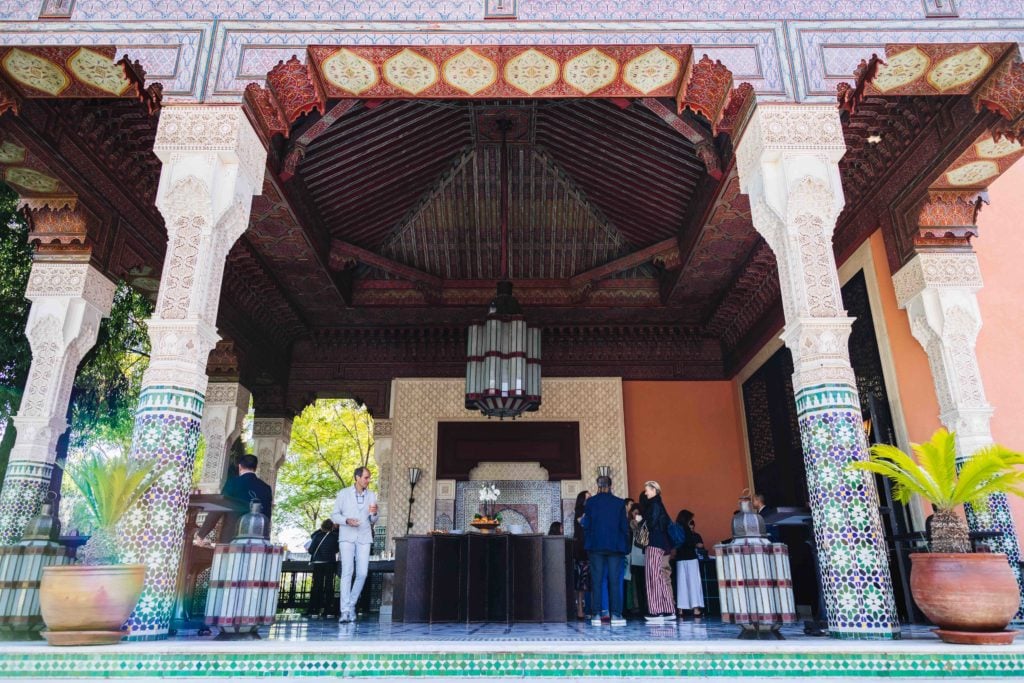
The fair has lots of big names, but there is also plenty to discover.

Naomi Rea

The second edition of the 1-54 art fair in Marrakesh kicked off yesterday at the swanky Mamounia hotel, opening its doors to VIPs and press ahead of its public opening this weekend, February 23 and 24.
The fair—which is dedicated to contemporary art from Africa and its diaspora, and which steadily built its reputation with editions in London and New York over the past seven years—launched its Moroccan venture last year to much fanfare.
The buzz has clearly paid off: the glamorous preview yesterday was buzzing with luminaries such as the legendary artist and French film director Agnès Varda, who was seen checking out Djamel Tatah’s work at Galerie Poggi. Also in attendance were Marrakesh Biennial founder Vanessa Branson and the chairman of the BRAFA art fair, Harold t’Kint de Roodenbeke, who was seen roaming the stands.
Limited by the size of the venue, the boutique fair included 18 galleries showing work by more than 65 artists. While some galleries decided to bring established stars—London’s Vigo Gallery presented works by Ibrahim El-Salahi, which were snuggled next to the booth of the Italian gallery Primo Marella, showing work by Abdoulaye Konaté—the fair remains a haven for discovery. Here are 5 artists to watch.
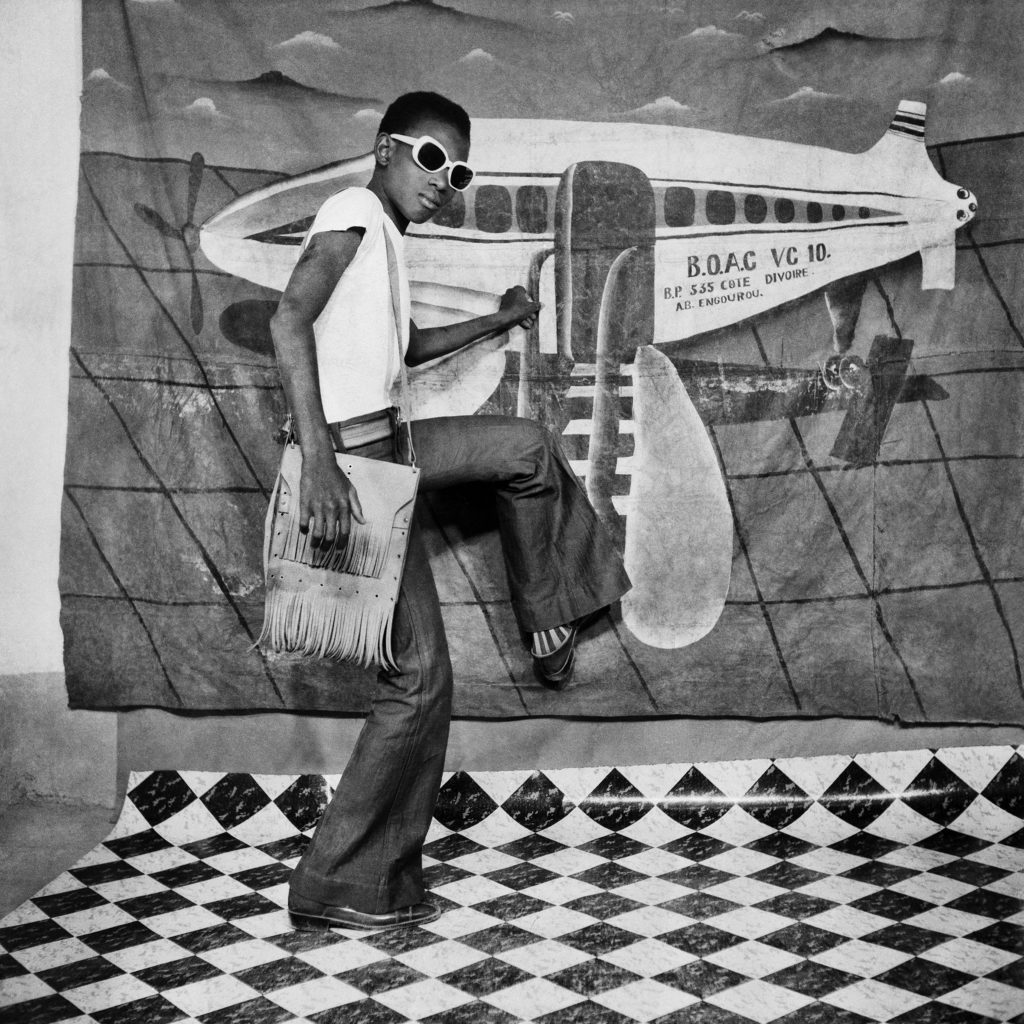
Sanlé Sory, Je vais décoller (1977). © Sanlé Sory. Courtesy of Yossi Milo Gallery, New York.
This 75-year-old Burkinabe is best known for his striking studio photographs taken in the era following Burkina Faso’s independence from France. Just as Malick Sidibé captured the atmosphere of post-independence Mali in his atelier, Sory’s studio became the locus for the vibrant youth culture of 1960s Upper Volta (as Burkino Faso was then known), with customers and friends from the small West African nation posing with props in front of painted backdrops.
Sory, who worked variously as a journalist, photographer, and record sleeve illustrator, had public exhibitions as early as 1998, but he is only now getting his full due. In 2018, the Art Institute of Chicago presented his work, and it is now in the collections of MoMA and the High Museum in New York, among other institutions. The New York gallery showing Sory’s photographs said the fair is off to “a great start” and that it had already sold a few pieces. The gelatin silver prints were selling for a very reasonable $5,000.
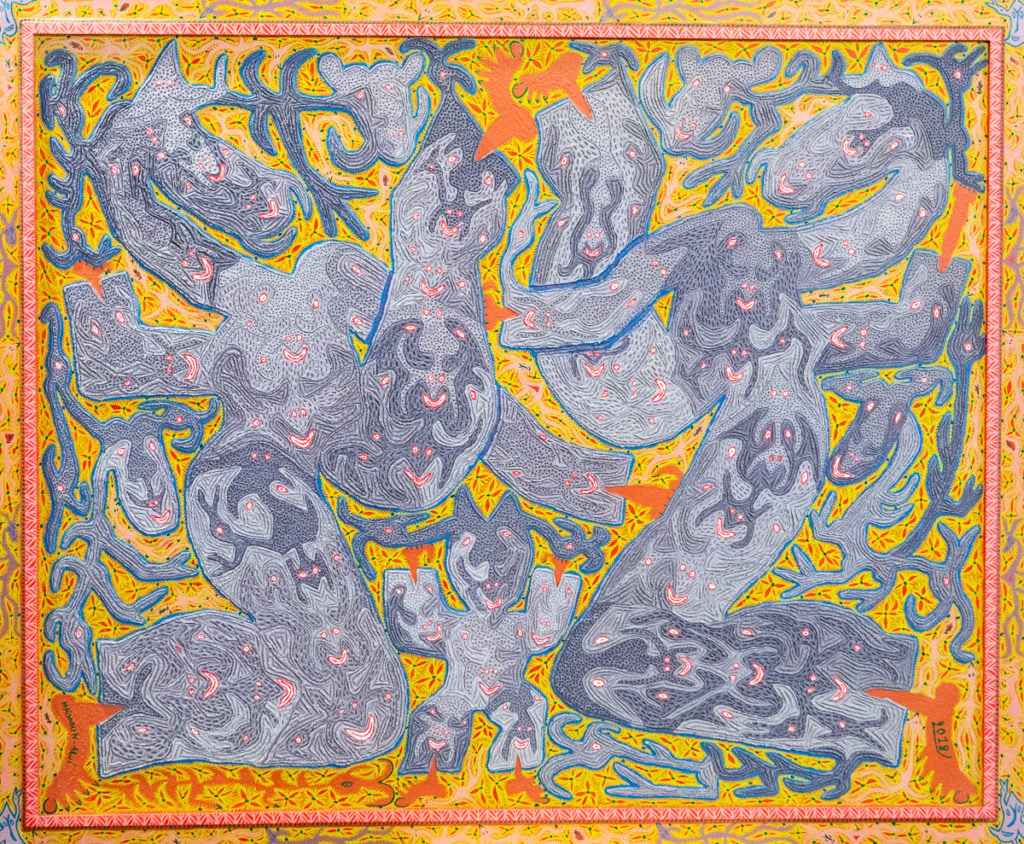
Ali Maimoun, Untitled (2018). Courtesy Galerie SINYA28.
Newcomers to the fair—and the only Marrakesh-based gallery in attendance—SINYA28 made a splash by selling five works by the second preview day of the fair, with prices ranging from €2,500 to €6,000.
Gallery director Hadia Temli is the daughter of the well-known gallerist behind Galerie Tindouf, Boubker Temli. Unlike her father, however, Hadia Temli specializes in younger, emerging artists. Speaking to artnet News, Temli said her goal in creating the gallery less than three years ago was to democratize art, and make it accessible to younger and amateur collectors.
“This is why I don’t mind being the ‘cheapest’ gallery at the fair,” she explained. “I believe that art is for all.”
The gamble has paid off. Her stand presented works by a cohort of outsider artists from a small port city about two hours outside of Marrakesh called Essaouira. The little-known city, which played host to Jimi Hendrix for a period during the 1960s, has in recent years produced a school of exceptional self-taught artists originally trained as manual laborers, carpenters, and fishermen.
Alongside works by Abdelmalek Berhiss, whose pointillist works resemble Aboriginal motifs, the stand had examples by Ali Maimoun (a trained stonemason), whose art is especially impressive. From afar, the textured paintings look like they could be embroidered, but they are actually made with sawdust mixed with pigments and acrylic paint. His large-scale work from 2018, pictured above, sold in the first hours of preview day for €4,500.
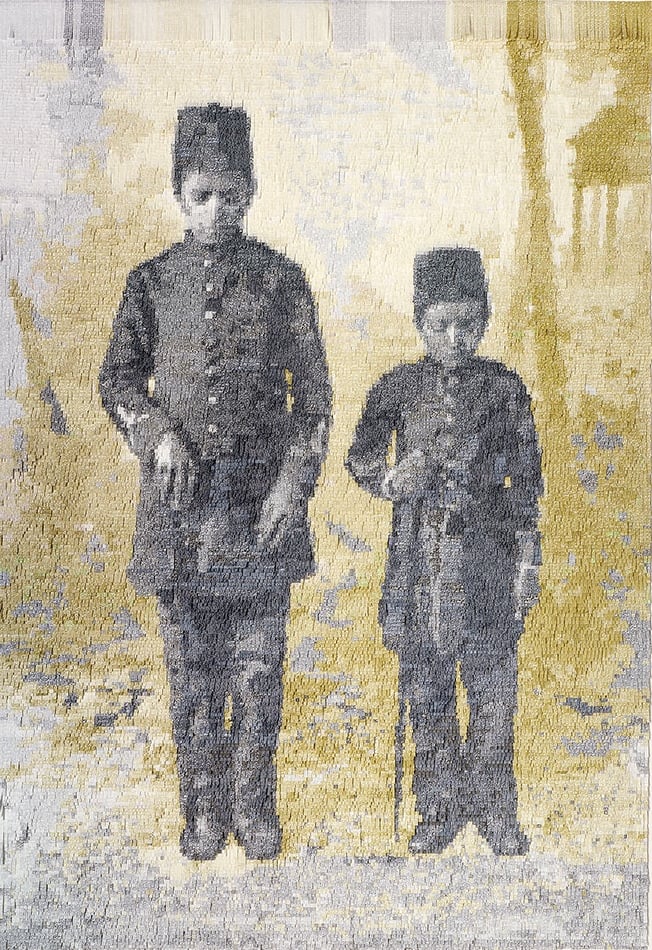
Nathalie Boutté, Les Jeunes Aveugles (2017). Photo © Florian Kleinefenn. Courtesy MAGNIN-A Gallery, Paris.
Born in 1967, Boutté is a self-taught French artist who recreates historic photographs, including early images of Africans and African Americans, through a meticulous cutting and pasting process. Her collages are made from re-purposed paper strips, taken from all kinds of sources, from novels to maps to banknotes. One of her intricate, three-dimensional works was on sale at the booth of Magnin-A, the gallery founded in 2009 by André Magnin after he spent 20 years managing the renowned private collection of Jean Pigozzi, known for his interest inc contemporary African art.
Boutté—whose work is in demand because of how long it takes her to create each piece—was doubly represented at 1-54. At Magnin-A, a work titled Les Jeunes Aveugles (2017) was priced at €28,000. Elsewhere, her New York gallery Yossi Milo was selling another work for around $20,000.
On preview day, Magnin-A also sold a work by JP Mika for €20,000 and some works by Omar Victor Diop ranging between €4,000 to €8,000 for smaller pieces, and €8,000 to €12,000 for larger ones.
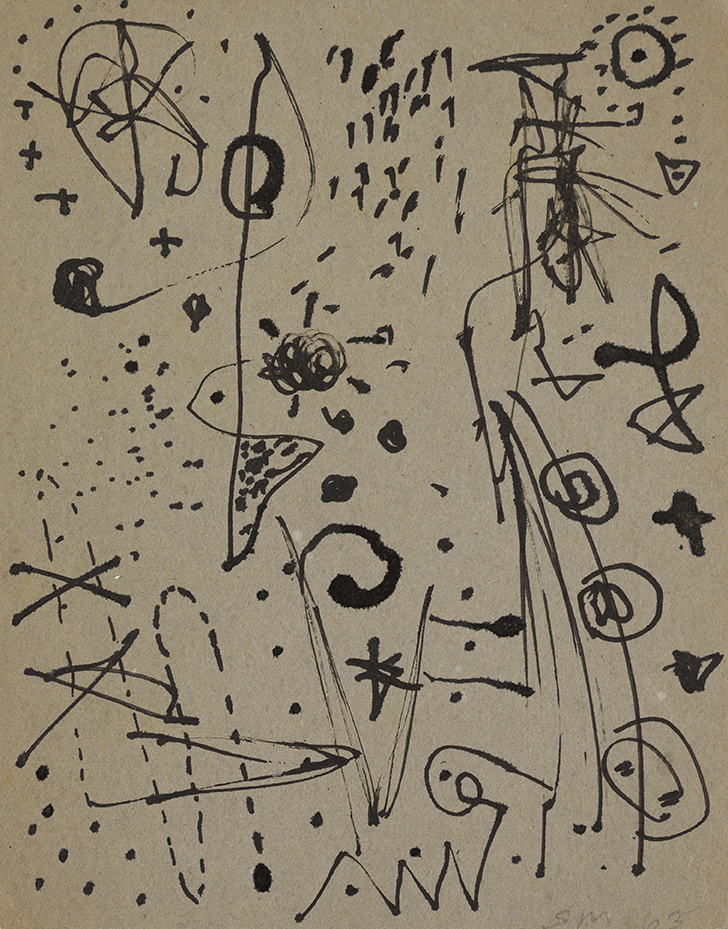
Sonja Ferlov Mancoba, Untitled (1963). Courtesy the artist and Galerie Mikael Andersen.
Sonja Ferlov Mancoba was a Danish artist important in the country’s 20th-century avant-garde. She was also a close friend of Alberto Giacometti and circulated with the likes of Max Ernst. Although her primary interest was in sculpture, her ink drawings were on display at the Danish gallery Mikael Andersen alongside work by her husband, Ernest Mancoba (a key figure in the history of African Modernism) and their son, Wonga Mancoba.
Sonja was overlooked during her lifetime compared with the recognition bestowed on her husband, but is belatedly receiving attention. She is currently the subject of a retrospective at the National Gallery of Denmark, and both her and Ernest will have exhibitions at the Centre Pompidou in Paris this June. Sonja will be the first Danish artist ever exhibited at Pompidou. Although the gallery declined to report any sales, they asserted a “positive and encouraging response” from the fair.
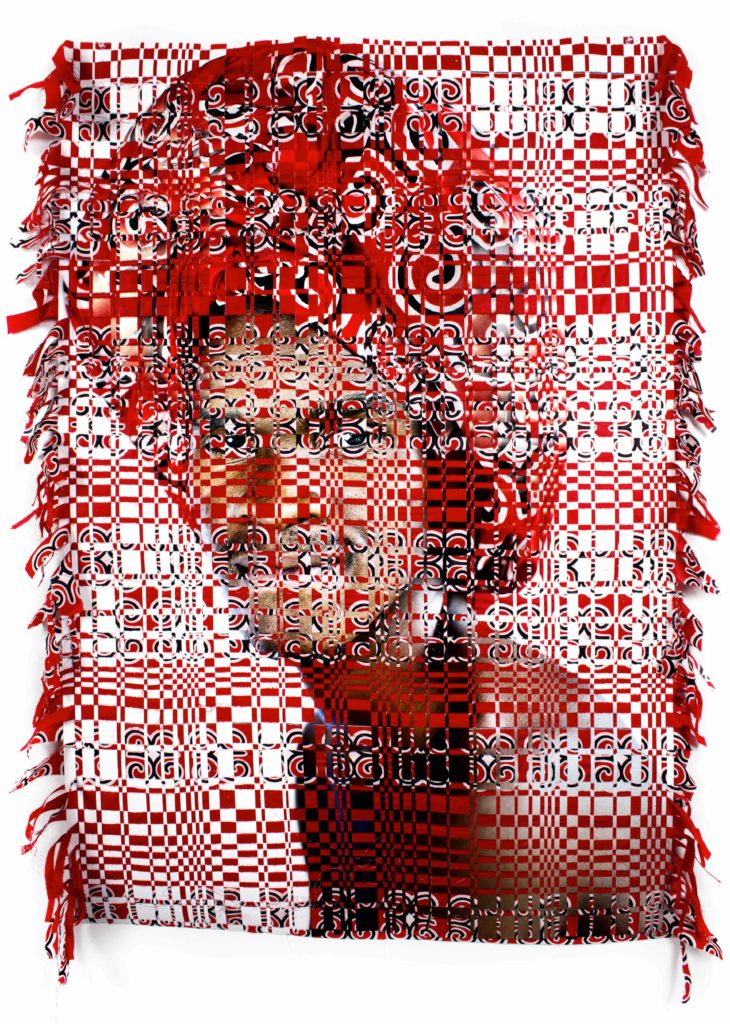
Kyle Meyer, Unidentified 156 (2019). ©Kyle Meyer, Courtesy Yossi Milo Gallery, New York.
Kyle Meyer’s moving portraits of Swaziland’s marginalized LGBTQ community earn dealer Yossi Milo a second mention. The 33-year-old US artist subverts the country’s hyper-masculinized culture in his “Interwoven” series, for which photographs queer men in traditionally female head wraps. He later uses the fabrics, selected by his subjects, and weaves them into large-scale prints to created a textured work that is at once beautiful and functional, because it conceals the identities of his subjects, whose sexual orientations are punishable by law in Swaziland. The eye-catching works were priced at around $30,000.